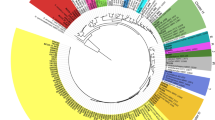Summary
Knowledge on the antibiotic susceptibility of pathogenic fermentative actinomycetes is still fragmentary and contradictory, which is one reason why even today the chemotherapy of human actinomycosis may still present problems. Complete and reliable data on the in vitro sensitivity of these pathogens can be obtained, however, when standardized and specially adapted methods of susceptibility testing are employed. Special adaptation should cover the general technique of in vitro testing, as well as the choice of test media, the preparation of inocula, incubation methods and method of reading results. Provided that all factors are taken into account which might cause difficulties in test reproducibility and therapeutic relevance of the results, in vitro tests appear to contribute to the revision and updating of treatment regimes for actinomycosis. Our findings indicate that, apart from ampicillin the clinical efficacy of which has already often been proved, mezlocillin, cefoxitin, clindamycin, tetracyclines, rifampicin and erythromycin may be recommended as alternative drugs which would seem to offer good chances of success.
Zusammenfassung
Kenntnisse über die Antibiotika-Empfindlichkeit pathogener, fermentativer Aktinomyzeten sind noch immer lückenhaft und widersprüchlich. Das ist wohl ein Grund, warum die Chemotherapie menschlicher Aktinomykosen bis heute nicht völlig problemlos geworden ist. Vollständige und verläßliche Daten zur In-vitro-Resistenz dieser Krankheitserreger lassen sich jedoch inzwischen erheben, wenn man standardisierte und besonders adaptierte Methoden zur Empfindlichkeitsprüfung verwendet. Spezielle Abstimmung sollten neben der allgemeinen Technik der In-vitro-Testung auch die Auswahl der Nährmedien, die Herstellung des Inokulums, die Züchtungsverfahren und die Ablesetechnik erfahren. Unter der Voraussetzung, daß alle Faktoren, die für Schwierigkeiten bei der Reproduzierbarkeit und klinischen Relevanz der Ergebnisse verantwortlich sein können, ausreichend berücksichtigt werden, können In-vitro-Prüfungen offenbar dazu beitragen, das Therapieschema der Aktinomykosen zu überprüfen und auf den neuesten Stand zu bringen. Nach unseren Befunden können neben Ampicillin, dessen klinische Wirksamkeit sich inzwischen vielfach erwiesen hat, auch Mezlocillin, Cefoxitin, Clindamycin, Tetracycline, Rifampicin und Erythromycin als weitere Therapeutika mit voraussichtlich guter Erfolgschance empfohlen werden.
Similar content being viewed by others
Literature
Schaal, K. P., Leischik, W. Zur Antibiotikatherapie der Nocardiose, Dtsch. med. Wschr. 94 (1969) 2505–2507.
Schaal, K. P., Schütt-Gerowitt, H., Pape, W. Cefoxitin-Empfindlichkeit pathogener aerober und anaerober Aktinomyzeten. Infection 7 Suppl. 1 (1979) 47–51.
Schaal, K. P. Die Aktinomykosen des Menschen — Diagnose und Therapie. Dtsch. Ärztebl. 31 (1979) 1997–2006.
Spieckermann, Ch. Die In-vitro-Empfindlichkeit vonActinomyces israelii, Actinobacillus actinomycetemcomitans undBacteroides melaninogenicus gegenüber Cephalothin, Cephaloridin, Gentamycin, Fusidinsäure und Lincomycin. Int. J. Clin. Pharmacol. 4 (1970) 318–320.
Lentze, F. Zur antibiotischen Therapie der Aktinomykose. Fortschr. Kiefer-Gesichtschir. 3 (1957) 306–313.
Peabody, J. W., Seabury, J. H. Actinomycosis and nocardiosis. A review of basic differences in therapy. Am. J. Med. 28 (1960) 99–115.
Slack, J. M., Gerencser, M. A. Actinomyces, filamentous bacteria. Biology and pathogenicity. Burgess Publishing Co., Minneapolis 1975, pp. 89–101.
Sutter, V. L., Finegold, S. M. Susceptibility of anaerobic bacteria to 23 antimicrobial agents. Antimicrob. Agents Chemother. 10 (1976) 736–752.
Fritsche, D. Untersuchungen über die Empfindlichkeit desActinomyces israelii und zwei seiner häufigsten anaeroben Begleitbakterien gegen neuere Antibiotika. Z. Hyg. Infektionskr. 150 (1964) 50–57.
Fritsche, D. Zur bakteriziden Wirkung des Penicillins auf den Erreger der Aktinomykose. In:Heite, H. J. (Hrsg.): Krankheiten durch Aktinomyzeten und verwandte Erreger. Springer, Heidelberg 1967, pp. 29–34.
Blake, G. C. Sensitivities of colonies and suspensions ofActinomyces israelii to penicillins, tetracyclines, and erythromycin. Br. Med. J. 1 (1964) 145–148.
Suter, L. S., Vaughan, B. F. The effect of antibacterial agents on the growth ofActinomyces bovis. Chemother. 5 (1955) 557–560.
Howell, A. In vitro susceptibility ofActinomyces to terramycin. Antibiot. Chemother. 3 (1953) 378–381.
Hanf, U., Heinrich S., Legler, F. Untersuchungen über die Empfindlichkeit des Erregers der Aktinomykose gegen Antibiotica (Penicillin, Streptomycin, Aureomycin, Chloromycetin, Terramycin) und Methylenblau. Arch. Hyg. 137 (1953) 527–537.
Garrod, L. P., Scowen, E. F. The principles of therapeutic use of antibiotics. Br. Med. Bull. 16 (1960) 23–28.
Author information
Authors and Affiliations
Rights and permissions
About this article
Cite this article
Schaal, K.P., Pape, W. Special methodological problems in antibiotic susceptibility testing of fermentative actinomycetes. Infection 8 (Suppl 2), S176–S182 (1980). https://doi.org/10.1007/BF01639887
Issue Date:
DOI: https://doi.org/10.1007/BF01639887



